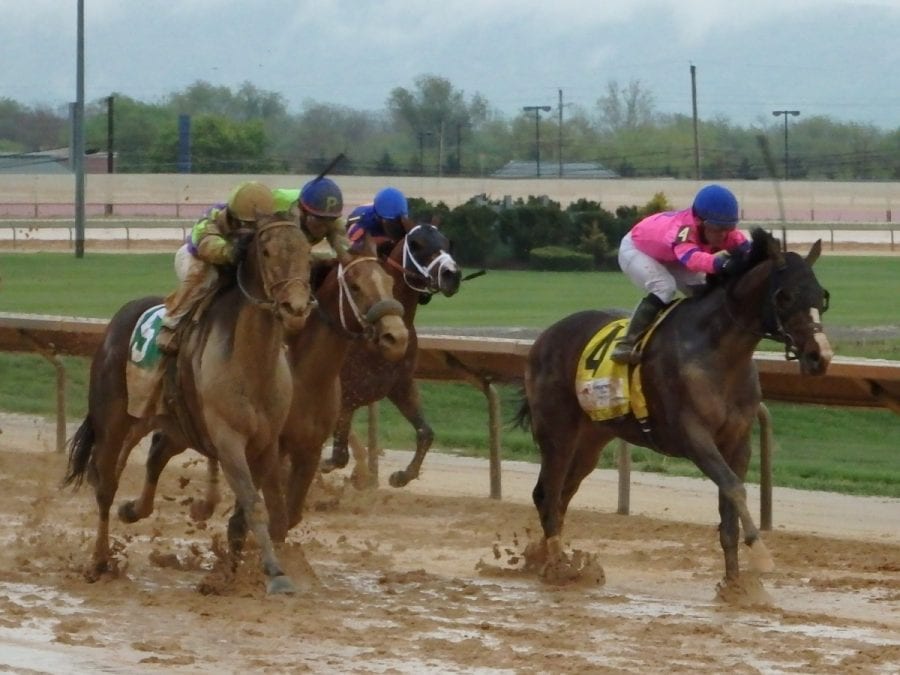Charles Town: Stakes slate put on hold by WV Commission

Imperative (outside) was up late to win the 2017 Charles Town Classic over Matt King Coal (#4) and War Story. Photo by The Racing Biz.
by Frank Vespe
Following a contentious discussion, the West Virginia Racing Commission this morning voted to table Charles Town’s proposed 2018 stakes schedule, leaving the track’s biggest event, the Grade 2 Charles Town Classic, in limbo, at least for now.
As required by state law, the track had requested approval for the six open stakes on its calendar; in addition to the Classic, those include the Grade 3 Charles Town Oaks, as well as the Sugar Maple, Robert Hilton Memorial, Russell Road, and Pink Ribbon Stakes. The remainder of the track’s stakes program is filled out by state-bred events and the West Virginia Breeders Classics.
But it was the Classic — with its $1.25 million purse — that dominated the discussion.
“I have a problem with $1.2 million for the Charles Town Classic,” commissioner Ken Lowe said. “I think the money could be better spent. I cannot justify giving $1.2 million to a horse who, 99.99 percent of the time, is going to be from out of town. I don’t see the benefit to the community.”
Lowe argued that the money could be better spent, for example, by running 10 $100,000 races or four events at $250,000 each. Those, he suggested, would have more participation from local horsemen and be better for the state’s racing industry, and community of Charles Town more broadly.
Charles Town officials countered that the sizable purse was necessary to attract the high-end horses that have enabled the race to attain its national prominence — and that that prominence had benefited the track and the racing industry as a whole. The Classic is one of just 12 races in the mid-Atlantic that have attained Grade 1 or Grade 2 status and the only one of those for older horses on the main track.
Calling it “the cornerstone of our racing program here,” racing secretary Charlie McIntosh said that the track had had to overcome three major hurdles in attracting horses: that it races at night, is hard to get to, and has a bullring, six-furlong track.
It has taken steps to resolve the first two of those — the Charles Town Classic card takes place during the day, for example, and the track has worked with the Tex Sutton Company to ease air travel to the area — but the bullring track isn’t going anywhere. That leaves the track to try to make up ground on its rivals by offering a better purse.
“For a small track like us, that’s the one advantage we have,” said Erich Zimny, the track’s vice president of racing operations.
Zimny said that the Classic competes with Oaklawn Park’s Grade 2 Oaklawn Handicap for horses. That race now sports a $750,000 purse, and with that track’s higher national profile, has other advantages that Charles Town must counter.
“We strongly disagree that (the high purse of the Classic) isn’t necessary to draw the type of horses we want to draw,” Zimny told the commissioners.
What’s more, he said that the Classic had been the linchpin of growth that has seen the track set handle-per-race marks three straight years, with a fourth all but assured in 2017. Per-race handle is up by 65 percent since the inception of the race, Zimny said. The national attention focused on the Classic has spun off to more eyeballs on the rest of the track’s product.
“We’ve used our events earlier in the year (like the Classic) to promote the local folks, as well,” Zimny said.
In the end, Lowe said that he would be willing to live with a $300,000 purse for the Classic.
Not enough, said the racetrack.
“If that’s what we’re stuck with, we’ll probably kill the race,” responded McIntosh.
That left Commission chairman Jack Rossi vainly searching for a compromise that proved elusive. Stakes purses amount to eight percent of the previous year’s purses each year. Though the development of that structure typically is a negotiation between the track and its horsemen, the Commission has broad legal authority to intervene.
“What we probably need to do is perhaps we delve more into the information,” Rossi said. If it takes a couple of additional weeks to reach “some sort of compromise,” that would be a good outcome.
And that’s what the Commission decided to do.








Charles Town is competing with Oaklawn? Why not aim higher than another racino in Arkansas, which isn’t exactly a major racing jurisdiction? Why not try to enhance the overall fan and family experience of Charles Town and try to compete with tracks in major racing jurisdictions like CA, DE, FL, KY, MD, and NY? Aiming to out-class another racino in AR is not exactly a high mark. This high mark would be a much better use of the money. Do Pletcher or Baffert even personally show up at Charles Town and avail themselves to the fans when one of their horses run in the CT Classic? If they have, I’ve never seen them there. Ken Lowe has a valid point.
He’s not saying they’re competing with Oaklawn in general – he’s saying they’re competing with Oaklawn for horses to run in the CT Classic, since the race is a G2 with a big purse, and they take place a week apart (or at least they did last year). So their challenge is to convince horsemen w/ G2-type horses to send those horses to CT versus sending them to OP.
We do not need out the money taken to outsiders when they are cutting race day and purses at Charles Town.
We do not need the purse money going outsiders when they are cutting race days and purses to locals in Charles Town.
They cannot Even turn the heat on in the undercover Grandstand.
If you think Oaklawn is not generally considered to be a major racing venue then you have no idea what you’re talking about.
About time someone protected the local people instead of Money going out of state.
Well done WV Commission stick to you guns.
I think Shared Belief’s injury put an end to any big-time horse ever entering this race.again. Last years race was, at best, equal to a grade 3 field. Track should use that money and be creative. Presque Isle Downs has a series of route races that get longer and longer as the meet progresses. Horses that have won the most points at the end of the series of route races split the bonus money
between the connections with the most points. I too, would like to see that money go to the local horse people.
Sad because his injury had literally nothing to do with the track. He hit the gate.
While its a noble thought the vast majority of races are for WV breds and and the rest ran by locals. As the article notes there are only six open races. Six all year at the busiest racetrack in the country. How many WV Bred Stakes can you have? The track only has three distances. Furthermore those races are generally dominated by one or two horses and represent little betting interest.
The CT Classic is the one single day of the year people look at Charles Town for something other than restricted stakes or claiming races. I actually preferred it at night, but if they saw an increase in handle then so be it. Locals can run in it if they want. Page McKenney came in second last year. In all racing its one of the hardest races to win. The favorite has won maybe once or twice.
As some of the other commentators have noted, for the last years the field was pretty weak. If they cant improve the field they might need to try something else. Move to 1 1/4 maybe (I can dream)? Charles Town has always had one of the worst condition books in the country, with nearly no open races. Lets keep the few on there that are actually drawing some attention.
Not to nitpick, Decimus, but there are 5 distances at Charles Town. Right or wrong, Shard Belief’s injury, in my opinion, will prevent any big-time horse from racing at Charles Town. I think 2017’s field proves that. The racing secretary writes races that fills the card. If 50% of the horses on the grounds are W.V Breds, then half the races are going to be state bred races.
I agree, there should be more open stakes. I know where they can get 1.2 million and write 6 nice open $200,000 stake races!